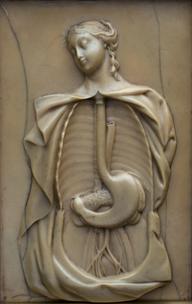





Guyon's trepan for perforating the foetal skull in embryotomy, cylindrical blade with gold-plated sliding guard and traction handle at distal end, by Collin, circa 1865
Guyon’s trepan is a destructive tool. It is used during an embryotomy. This is the destruction of the foetus when natural childbirth is impossible. It was developed by French obstetrician Jean Casimir Félix Guyon (1831-1920). A trepan was one of many surgical instruments an obstetrician might take when attending a birth. The trepan perforated the foetal skull before collapsing it. It was only used when there was significant risk to the mother or in the case of still birth. This gold plated example dates from the mid-1800s. It was made by French instrument maker Collin.
Details
- Category:
- Obstetrics, Gynaecology & Contraception
- Collection:
- Sir Henry Wellcome's Museum Collection
- Object Number:
- A606234
- Materials:
- steel, plated, gold, plated and vulcanite
- Measurements:
-
overall: 32 mm x 335 mm x 110 mm, .23 kg
- type:
- obstetrical trepan
- credit:
- Drouot




